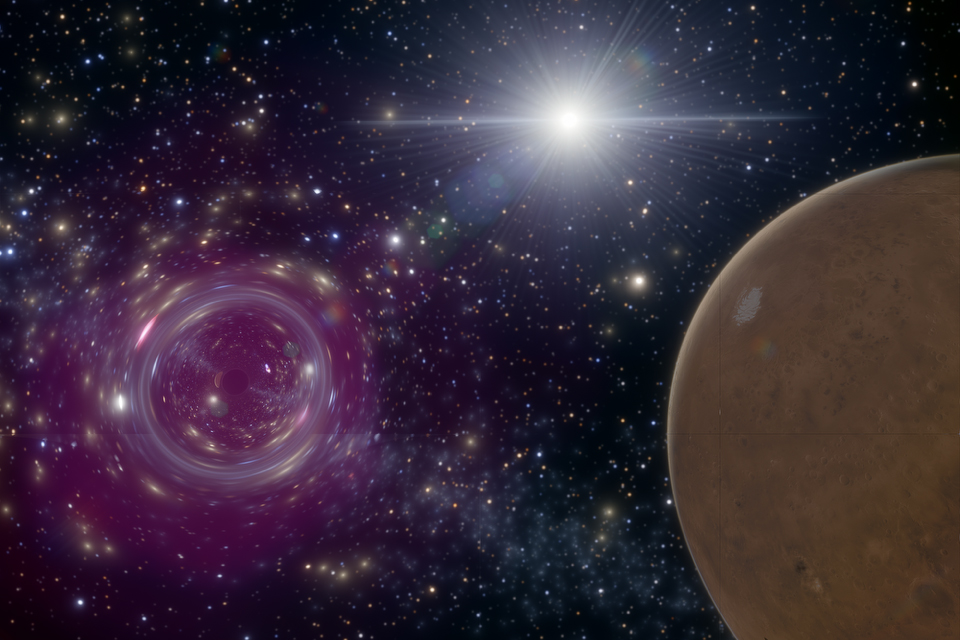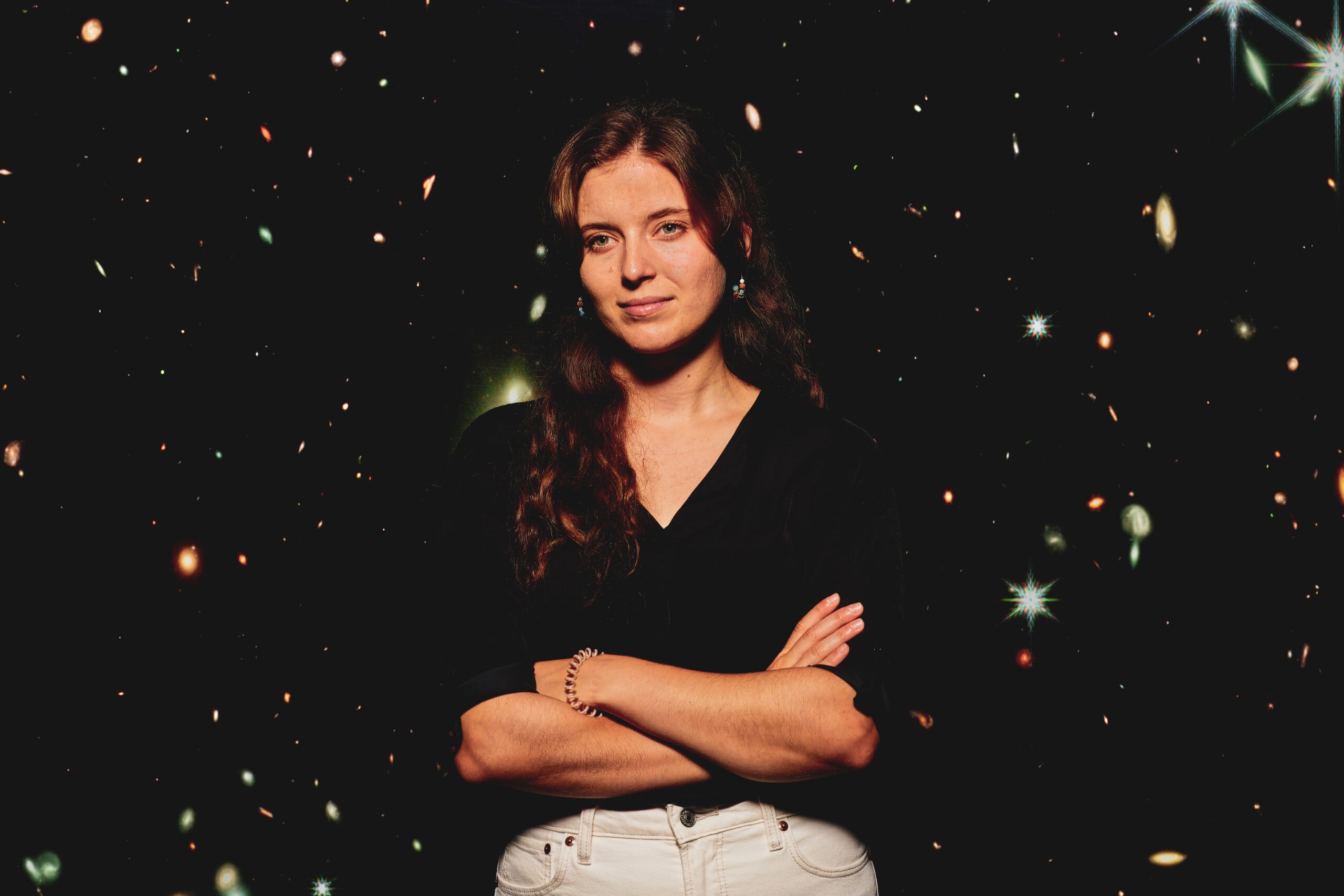In a groundbreaking study, physicists from MIT put forward an intriguing hypothesis: if a significant portion of the universe’s dark matter comprises microscopic primordial black holes — a concept introduced in the 1970s — these elusive gravitational entities should traverse our solar system approximately once every decade. The researchers suggest that such a flyby could generate a detectable wobble in the orbit of Mars.
Detecting this wobble could substantially bolster the theory that primordial black holes are a fundamental component of dark matter throughout the cosmos.
“Thanks to decades of precise telemetry, scientists can measure the distance between Earth and Mars with an accuracy of about 10 centimeters,” states David Kaiser, study author and professor of physics at MIT. “We leverage this well-monitored region of space to search for subtle effects. If detected, it would provide strong evidence to further investigate the captivating notion that dark matter may consist solely of black holes formed within seconds of the Big Bang, continuously moving through the universe for 14 billion years.”
Kaiser and colleagues shared their findings in the journal Physical Review D. Co-authors include lead author Tung Tran ’24, currently a graduate student at Stanford University; Sarah Geller ’12, SM ’17, PhD ’23, now a postdoctoral researcher at the University of California, Santa Cruz; and Benjamin Lehmann, a fellow at MIT Pappalardo.
Exploring Beyond Particles
Interestingly, less than 20 percent of all matter in the universe consists of observable entities like stars and planets. The remaining majority is believed to be dark matter — a mysterious and invisible form that pervades the cosmos, exerting a gravitational influence strong enough to sway the movement of galaxies.
Researchers have set up detectors on Earth in an effort to identify dark matter and understand its characteristics. Despite extensive attempts focusing on exotic particles that might scatter and decay into observable forms, these searches have yet to yield results.
Recently, a resurgence in a previously considered theory has gained momentum: dark matter may exist as tiny primordial black holes created in the universe’s infancy. Unlike typical astrophysical black holes that arise from collapsing stars, primordial black holes would form from densely packed gas in the early universe, scattering throughout space as it expanded and cooled.
These primordial black holes could potentially contain massive amounts of mass in a small volume, ranging in size from a single atom to the mass of large asteroids. This leads to the fascinating possibility that such “tiny giants” could play a significant role in explaining dark matter. Inspired by this concept, Kaiser and his team posed an initially whimsical question.
“A colleague posed the question: What if a primordial black hole zipped by a human?” recalls Tung. A quick calculation revealed that if one swung within a meter of a person, its gravitational influence could propel that person approximately 6 meters, or about 20 feet, in just one second. However, the chances of such a black hole traversing near someone on Earth are astronomically low.
With curiosity stirred, the researchers expanded their calculations to predict how a black hole’s passage might influence larger celestial bodies like Earth and its moon.
“We hypothesized the effect of a black hole’s near pass on Earth, specifically regarding the moon’s wobble,” Tung explains. “The results were initially unclear due to numerous other dynamic factors in the solar system that could minimize any detectable wobble.”
Understanding Close Encounters
To gain a clearer understanding, the team created a simple simulation of the solar system accounting for the orbits and gravitational interactions of various planets and moons.
The researchers calculated the frequency with which a primordial black hole should pass through our solar system, based on estimated dark matter density and the mass of the black hole, hypothesizing it to be similar to the largest asteroids in our solar system.
“Primordial black holes don’t remain stationary in our solar system; they’re drifting through the universe and passing through at various angles about every 10 years,” says co-author Sarah Geller.
Using this frequency, the researchers simulated various black hole approaches, analyzing their impacts as they moved at speeds of roughly 150 miles per second — data sourced from other studies on the distribution of dark matter in our galaxy. They focused on “close encounters” that could affect surrounding celestial bodies. Though alterations to Earth or the moon proved too ambiguous in association with a specific black hole, Mars presented a clearer target.
The study concluded that if a primordial black hole were to skim within hundreds of millions of miles from Mars, the planet’s orbit could exhibit a detectable wobble. Over a few years post-flyby, Mars could shift just over a meter— an incredibly subtle change given its distance of over 140 million miles from Earth. Remarkably, this wobble could be identified by the high-precision instruments currently monitoring Mars.
Should this wobble be observed in the coming decades, more research would be needed to ascertain whether it was indeed influenced by a passing black hole or merely the result of an ordinary asteroid.
“We must carefully analyze the expected background noise, such as usual asteroid velocities and distributions versus the distinctive trajectories primordial black holes would take,” Kaiser explains. “Fortunately, astronomers have tracked ordinary asteroids as they’ve traversed the solar system, allowing us to establish typical patterns and begin differentiating them from the unique signatures of primordial black holes.”
To advance their efforts, the researchers aim to collaborate with a team experienced in simulating numerous solar system objects.
“We are developing simulations that include various celestial bodies from planets to asteroids, examining their long-term movements,” Geller adds. “This will help us identify close encounter scenarios with increased accuracy.”
“This proposal is a fascinating test that could reveal whether the nearest black hole is closer than we think,” comments Matt Caplan, associate professor of physics at Illinois State University, and not involved with the study. “It’s essential to emphasize that luck plays a part; whether a search identifies a clear signal hinges on the exact trajectory of a wandering black hole through the solar system. Now, equipped with simulation insights, they must verify their predictions against real observational data.”
This research received support from the U.S. Department of Energy and the National Science Foundation, including an NSF Mathematical and Physical Sciences postdoctoral fellowship.
Photo credit & article inspired by: Massachusetts Institute of Technology



